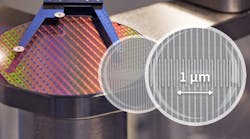Infineon Technologies is currently participating as an industrial partner in a number of national and European funded projects. In the technological race for better quantum computing technology is still open. Essentially, scientists are pursuing three paths to the physical technical implementation of the crucial basic elements, the qubits: superconducting qubits, ion trap-based qubits and silicon-based spin qubits. Infineon is researching and developing all three approaches with the potential for industrial implementation, contributing semiconductor and industrial expertise to several consortia on quantum technology, including the funded projects GEQCOS for superconducting qubits and PIEDMONS for ion trap-based quantum computing.
Now the company is also collaborating in the QUASAR project, which focuses on silicon-based spin qubits. This project is funded by the German Federal Ministry of Education and Research (BMBF) as part of the funding program "Quantum Technologies - from Basic Research to Market" (contract number: 13N15656). QUASAR aims to lay the foundations for the industrial production of quantum processors over the next four years. The goal is a semiconductor quantum processor based on the exchange of electrons ("shuttle") and to be realized with technology available in Germany.
To this end, scientists from Forschungszentrum Jülich, institutes of the Fraunhofer-Gesellschaft and the Leibniz Association, the universities in Regensburg and Konstanz, the quantum start-up HQS and Infineon Dresden are working together. The project is coordinated by Forschungszentrum Jülich. "A key advantage is that silicon-based spin qubits are robust, fast and at the same time have excellent scaling potential," says Claus Dahl, Director Automotive Sense and Control at Infineon Dresden.
In silicon-based qubits, quantum information is encoded by the spin of electrons. These electrons are located at so-called quantum dots, special semiconductor structures in the nanometer range. Novel interconnect elements are to be used for the interaction between the qubits. These so-called quantum buses shall enable the transport of electrons in a controlled manner over distances of up to about 10 micrometers without losing the quantum information. In collaboration with quantum scientists at RWTH Aachen University, Infineon has already developed process engineering approaches for a scalable architecture for corresponding quantum processors.
In addition, Infineon Dresden is participating in the Quantum Large-Scale Integration with Silicon (QLSI) project of the European Quantum Flagship, which started in September 2020. Together with partners from the QUASAR project and other European institutions, Infineon is researching an industry-compatible fabrication approach for semiconductor qubits. The QLSI project is coordinated by the French research institute for electronics and information technology CEA-Leti.
"In close cooperation between academic and industrial research, we want to raise the quality in the fabrication of quantum devices to an industry-compatible level in these projects. After all, only by using industrial standard processes of CMOS technology to a large extent, the challenges in process integration can be mastered when scaling up to a complex product," explains Dahl.
Setting the course for European value creation potential
“If we in Germany and Europe don’t want to be dependent for this future technology solely on American or Asian know-how, we must move forward with the industrialization now,” says Sebastian Luber, Senior Director Technology & Innovation at Infineon. Quantum computing and its wider application are still in their infancy. The course is now being set for the technology competitors to differentiate a new dimension with their own know-how to the digitalization of business and society. The value creation potential of applying quantum computing is many times greater than in the technology itself. Infineon’s research projects play a major role in laying the foundation for implementing the current federal initiative to build a quantum computer “made in Germany”.
Partners of the QUASAR project
HQS Quantum Simulations GmbH is a KIT spin-off with 18 employees and focuses on quantum mechanical material simulations. HQS cooperates with companies such as BASF, BOSCH and Merck in the materials and chemicals sector.
The Fraunhofer Institute for Applied Solid State Physics develops hardware for quantum technology and electronic systems. The core competencies range from materials research, design and technology development, (cryogenic) measurement technology to circuits and systems.
The Leibniz Institute for Innovative Microelectronics conducts research and development on silicon-based high-frequency circuits and technologies, including new materials. It also offers prototype manufacturing via its 200 mm line.
The Leibniz Institute of Crystal Growth specializes in the growth of solid crystals, epitaxial thin films and nanostructures. The development and characterization of isotopically pure 28Si crystals deserves special mention.
With around 2,700 employees, Infineon Technologies Dresden GmbH & Co. KG is one of the most modern and largest semiconductor development and production sites in Germany. Infineon Dresden has two highly automated production lines covering about 50 different technologies. The Infineon Technolgies is strategically involved in post-quantum cryptography as well as various quantum hardware concepts such as ion traps, superconductors and approaches based on SiGe quantum wells. The latter are being investigated at the Dresden site.
Fraunhofer IPMS-CNT is working on innovative devices and technologies with the aim of integrating them into CMOS platforms. It has more than 40 industry-standard process facilities and comprehensive analytics as well as close links to the production lines of industrial project partners.
The JARA Institute for Information has locations at Forschungszentrum Jülich and RWTH Aachen University. The experimental group led by Prof. Hendrik Bluhm and Dr. Lars Schreiber has many years of experience in fabrication, coherent manipulation and modeling of semiconductor qubits. One of the research focuses is on their scalability.
The Chair of Condensed Materie Theory and Quantum Information at the University of Konstanz, led by Prof. Guido Burkard, has long been conducting research in the fields of quantum computing in solid-state systems, in particular spins in semiconductors, and two-dimensional materials.
The "Epitaxial Nanostructures" group at the University of Regensburg (UR) led by Prof. Dominique Bougeard investigates quantum effects in semiconductor nanostructures. The focus is on molecular beam epitaxy, nanooptics and electrical, quantum transport and in particular 28Si/SiGe-based hybrid structures as well as spin qubits.
